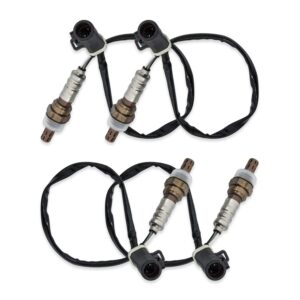Are All O2 Sensors the Same Thread Size? The Common Myth.
Not all o2 sensors are the same thread size. Thread size depends on the type and model of the vehicle.
Thread sizes can vary between 12mm, 14mm, and 18mm. It is important to know the correct thread size before replacing an o2 sensor. Oxygen sensors play an essential role in a vehicle’s emissions control system. They measure the amount of oxygen in the exhaust and send the information to the engine’s computer.

This helps ensure the proper air-to-fuel ratio for optimal engine performance while minimizing emissions. However, like all components, oxygen sensors wear out and need to be replaced. It’s important to note that not all o2 sensors are the same thread size. Thread size varies between 12mm, 14mm, and 18mm depending on the vehicle’s make and model. Before replacing an o2 sensor, it’s crucial to ensure the correct thread size to prevent damage to the exhaust system.
What Are O2 Sensors, And Why Do They Matter?

O2 sensors are a critical component of any vehicle’s emissions system. They measure the amount of oxygen in the exhaust gas, informing the engine control unit how much fuel to inject for efficient combustion. Many drivers believe that all o2 sensors are the same thread size, but this is a commonly believed myth that needs debunking.
In reality, the thread size of o2 sensors varies depending on the vehicle make and model. Choosing the wrong size could result in improper installation, leading to costly repairs and reduced fuel efficiency. As a responsible vehicle owner, it is essential to understand the importance of o2 sensors and ensure that you select the correct thread size for your vehicle.
The Truth About O2 Sensor Thread Sizes
There is a common myth that all o2 sensors have the same thread size, but this is far from the truth. In fact, o2 sensors come in a variety of sizes depending on the make and model of your vehicle.
It is crucial to ensure you purchase the correct size sensor for your car to avoid any issues with installation and functionality. This is why it’s important to do thorough research, consult with a professional mechanic, or refer to your vehicle’s manual to confirm the thread size of your o2 sensor.
Don’t make the mistake of assuming that all sensors are the same size – follow these guidelines to ensure that you choose the right sensor for your vehicle.
The Impact Of Using The Wrong O2 Sensor
Many vehicle owners believe that any o2 sensor can be used interchangeably despite a difference in thread size. However, using the wrong o2 sensor can have serious consequences on the engine’s performance and fuel economy. It’s important to note that not all o2 sensors are created equal, as thread sizes can vary depending on the vehicle manufacturer.
Failing to use the correct o2 sensor can cause engine misfires, decreased fuel efficiency, and even permanent damage to the catalytic converter. To avoid these potential issues, drivers should always consult their vehicle owner’s manual and purchase the correct o2 sensor for their specific make and model.
By following this guideline, vehicle owners can keep their engines running smoothly and ensure they achieve optimal performance and fuel economy.
How To Choose The Right O2 Sensor For Your Car
O2 sensors are not one-size-fits-all, and different vehicles require different thread sizes. To choose the right o2 sensor for your car, consider your vehicle’s make, model, and year to ensure compatibility. It’s also important to know whether your car has one or multiple sensors, and if they are located before or after the catalytic converter.
Some vehicles may require specific brands or types of sensors, so it’s important to do your research before purchasing. Additionally, quality should be taken into consideration; avoid buying cheap and unreliable sensors as they may cause harm in the long run.
With these guidelines in mind, selecting the right o2 sensor for your car can be done with ease and confidence.
Frequently Asked Questions Of Are All O2 Sensors The Same Thread Size
Are All O2 Sensors The Same Thread Size?
No, o2 sensors come in different thread sizes ranging from m18 to m12.
How Do I Determine My O2 Sensor’S Thread Size?
Check the vehicle’s manual or contact the manufacturer for specifications. Alternatively, measure the diameter of the threads using a caliper or thread gauge.
Can I Install An O2 Sensor With A Different Thread Size?
No, it is not recommended to install an o2 sensor with a different thread size. Doing so may damage the threads or lead to inaccurate readings.
What Happens If I Install The Wrong O2 Sensor Thread Size?
Installing the wrong o2 sensor thread size can result in stripped threads or damaged sensor signals, leading to inaccurate readings, reduced performance, and increased emissions.
Do All Vehicles Require O2 Sensors?
Most gasoline-powered vehicles built after 1996 require o2 sensors to monitor exhaust emissions and ensure proper engine performance.
How Often Should I Replace My O2 Sensor?
It is recommended to replace o2 sensors every 60,000 to 90,000 miles to ensure accurate readings and optimal engine performance.
Conclusion
As we have seen throughout this article, not all o2 sensors are the same thread size. This is a crucial aspect when it comes to replacing your sensor, as getting the wrong thread size can lead to further damage or even incorrect readings.
It is essential to understand your vehicle’s specifications and take the necessary measurements before purchasing a new o2 sensor. More importantly, investing in a quality o2 sensor can save you from costly repairs down the road. Keep in mind that a faulty o2 sensor can affect your vehicle’s performance, fuel economy, and overall emissions.
Therefore, it’s crucial to ensure you have the correct thread size and an accurate, reliable o2 sensor to keep your vehicle in top condition. Don’t take shortcuts when it comes to replacing your o2 sensor – invest wisely and keep your vehicle running smoothly.





0 Comments